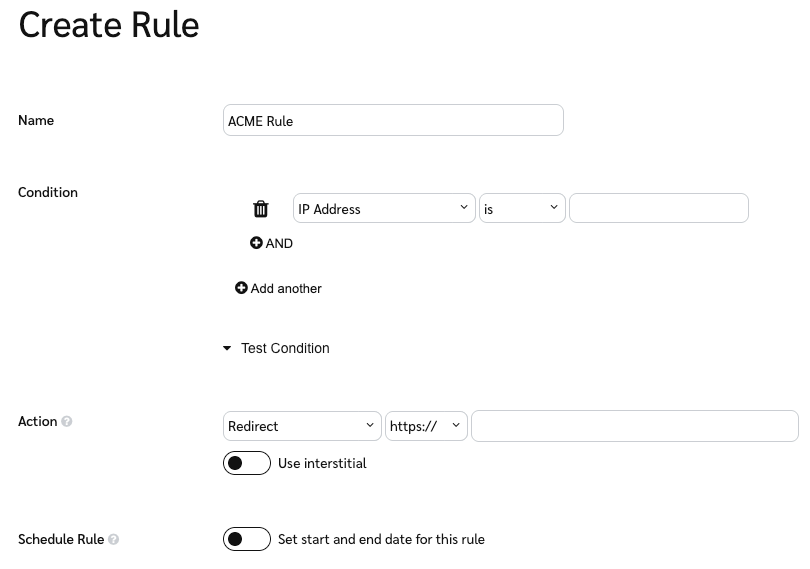From the top navigation bar, select
[User profile] → Settings.
On the right, under Technical, select Blocking & Redirect.
In the top-right corner, select Configure rule.
Add a Name for your rule.
In the Condition section, use the drop-down menus to configure your redirect rule.
Do not select Mobile Fallback unless you plan to make an app interstitial.
View the Conditions reference below to learn more about the different condition attributes.
In the Action, ensure the drop-down menu is set to Redirect, then select the protocol for the redirect link, and enter the destination URL.
If you want to have an interstitial web page,
[Toggle on] and configure Use interstitial. Ensure the Template drop-down menu is set to Custom.
Optionally, Schedule when this redirect rule will be active.
Rank the redirect rule.
If multiple redirect rules have the same conditions and the same Rank, the one with the lower ID will take priority.
If you don't want the redirect to begin immediately and you did not schedule the rule, you can Pause the rule.
You will need to manually unpause this rule for it to become active again.
Save your redirect rule.

Refer to the table below for more information about each of the options available for setting up a redirect interstitial.
Not all interstitial settings may be available depending on your account level. Reach out to your CSM (or contact support) to ask about upgrading your account.
Interstitial Setting | Description |
Header Text | A short phrase displayed on the interstitial in large type. |
Body Text | Information that traffic will see on the interstitial. |
Additional Terms (Premium) | Any additional terms or conditions of which redirected traffic should be aware. |
Require User Acknowledgement | A toggle that, when enabled, will require traffic to select a button on the interstitial page to finish the redirect. |
Button Text | If Require User Acknowledgement is toggled On, the word or phrase within the button that traffic must selected can be added. |
Button Color (Premium) | If Require User Acknowledgement is toggled On, the hex code for the button's color can be entered. |
Require User Input (Premium) | A toggle that, when enabled, allows traffic with a certain condition (or certain conditions) to bypass the interstitial. Requires the Require User Acknowledgement toggle to be enabled. |
Include Skip Option (Premium) | If selected, traffic can move through the interstitial and finish their redirect after a certain amount of time. Requires the Require User Acknowledgement and Require User Input toggles to be enabled. |
Show Page at Least Once (Premium) | If selected, all traffic will see the interstitial page at least once, even if they do have the proper parameter to bypass it. Requires the Require User Acknowledgement and Require User Input toggles to be enabled. |
Show Partner's Logo (Premium) | A toggle that, when enabled, will also show the logo of the partner that drove the redirected traffic on the interstitial page. |
Customize CSS (Premium) | A toggle that, when enabled, allows you to upload a custom CSS file for the interstitial page. |
Custom CSS (Premium) | If Customize CSS is toggled On, the interstitial page's custom CSS can be entered. |
Preview | Opens a new browser tab to preview the interstitial page. |
Condition setup works in an AND/OR system:
AND:
A specific condition is further refined.
Add another/OR:
An added separate condition that can, but does not necessarily need to, be met for the redirect rule to activate.
Condition Attribute | Description |
IP Address | The IP Address registered to a device. |
Shared Id | A partner-controlled query string parameter that is used in reporting. |
Country | The country from where traffic is sourced. |
Region | The geographical region from where traffic is sourced. |
Ad Status | The associated ad's state of use. |
Sub Id1 | A partner-controlled query string parameter that is used in reporting. |
Sub Id2 | A partner-controlled query string parameter that is used in reporting. |
Sub Id3 | A partner-controlled query string parameter that is used in reporting. |
MP Id | impact.com's unique Id for a partner. |
Device Type | What type of device the customer was using when the redirect rule is prompted to activate. |
Ref URL | URL of the website that is referring traffic to the original destination URL. |
Landing Page | The original destination URL. |
Product SKU | An Id for the subject of the ad, which is usually designated in a product catalog. |
Ad Id | impact.com's unique Id for an ad. |
Probability | The redirect rule will randomly grab a percentage of traffic to be rerouted. This is primarily used for A/B testing. |
Mobile Fallback | If an ad has mobile fallback configured, the associated routing rile can request to reroute traffic to their respective app store to download an app. Mobile fallback redirect rules are usually set up during Onboarding—check your tech specs to see if you should have a mobile fallback redirect rule. |